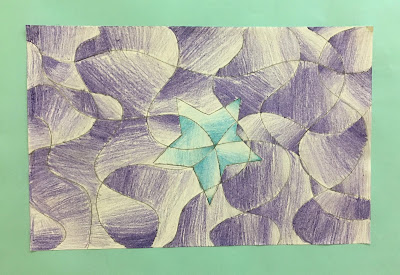
Monday, December 10, 2018
Georgia O'Keeffe Supersize Pastels
Second
graders learned about Georgia O’Keeffe, an American artist who celebrated the
details of nature by emphasizing color and size through painting with an
extreme close-up perspective. Sometimes
she focused so close-up that the paintings became abstract, or unrecognizable
as their original realistic forms. Second graders used oil pastels to create
their artworks. They chose a subject from nature and super-sized it to bring
focus to the beautiful colors and details.


Tuesday, November 27, 2018
Seventh Grade Shattered Value
Seventh graders have been working on a unit on value, an element of art which describes the use of light and dark for emphasis, dimensionality, and perspective. To practice their shading skills, they created these compositions made of contour drawings and dividing lines. Within each shape, they used pencil to shade from darkest to lightest, resulting in these mesmerizing drawings.
Kindergarten Expressionist Animals
Kindergarteners observed and compared two paintings of cows, Yellow cow by Expressionist artist Franz Marc (1911), and Children and a Cow by Albert Cuyp (1635). I asked them which painting they thought was older, and they figured it out. We discussed why Cuyp's painting looks older- the style of clothing, and the duller colors. I told them that was only within the last 150 years (which is a small amount of time in art, which has been around 10,000 years) that artists really started to "break the rules" and create things that did not look realistic. I explained that Expressionism was a kind of art where artists changed how things looked in order to express themselves, and we brainstormed other different ways people express themselves, such as through their words and their clothes.
They drafted their Expressionist animals in pencil on big 18x24 papers. Then, they outlined the animals in black paint. Finally, they used bright colors of their choice to create their beautiful paintings.
Wednesday, November 7, 2018
Fourth Grade Explores Kanga Cloth
Fourth graders learned about Kanga cloth from Tanzania. Kanga cloths have geometric patterns and include a message or a blessing in Swahili. They are gifted, traded, and worn as clothing.
The fourth graders designed their own prints inspired by Kanga cloth by creating an abstract design that communicated their message or blessing. They carved the design into styrofoam, then used printmaking techniques to create a series of prints, resulting in a pattern. Finally, they wrote out their blessing and created an additional border design with another geometric pattern.
Tuesday, October 16, 2018
Second Grade Self Portraits
Essential Question: What can we learn about an artist from their self-portrait?
Second Graders
created these portraits using pencil, then Elmer's glue, on black paper.
Finally, they added color with soft pastels. When the glue dries, it leaves
clear, smooth lines that resist the chalk pastels- resulting in raised outlines
that beautifully contrast with the vibrant colors. I love this project! It
allows for such creativity and color choice, and of course they love mixing the
colors with their hands. As an introduction to the project, we observed and
discussed self-portraits by Andy Warhol and Vincent Van Gogh.
Thursday, October 11, 2018
Third Grade Illuminated Letters
Essential Question: How (and why) in history
have people demonstrated that an object is important or special?
Illuminated manuscripts were created as early
as 1000-1500 years ago. The artists
would decorate or illuminate the first letter in an important book by adding
details and by finishing it with actual gold.
Third graders used sharpie and pencil to create these beautiful letters. Each letter includes a winding/scrolling thing, an animal, a pattern, and a plant. They illuminated their letters by using gold sharpie to highlight what they felt was the most important parts of their drawings.
Third graders used sharpie and pencil to create these beautiful letters. Each letter includes a winding/scrolling thing, an animal, a pattern, and a plant. They illuminated their letters by using gold sharpie to highlight what they felt was the most important parts of their drawings.
Subscribe to:
Posts (Atom)

























































